Minor Pentatonic Scale
The Minor Pentatonic Scale is the scale that is played on most songs that you know.
It is also the basis for most rock guitar solos. Some players only play the
Pentatonic Scale in their guitar solos. It's a very powerful scale.
The Pentatonic is named the Pentatonic because it only has 5 notes (Penta).
The scale intervals of the Minor Pentatonic are: 1 - b3 - 4 - 5 - b7
As with almost everything else on guitar, it is moveable pattern.
The pattern stays the same on any root note. Just move the pattern
up or down so the desired root note is on the 6th string.
A Minor Pentatonic Scale
For simplicity, we'll use C Major's Relative Minor, which is A Minor, since it contains no flats or sharps.
The notes of the A Minor Pentatonic Scale are : A - C - D - E - G
There are a few patterns (boxes) that everyone plays when learning the Pentatonic.
NOTE:
When learning each pattern, first try playing it as shown. Then try combining them with
The pattern you learned before it. For example: If you've learned pattern 1, and are now
learning pattern 2, first get comfotable with pattern 2 on its own. Once you are comfortable
playing pattern 2, stop. Play pattern 1, and then play pattern 2 right after it.
Another way to practice is to play half of pattern 1 (like the low E, A, and D strings),
then switch to pattern 2 on the higher (G, B, and E) strings.
This will also help with position shifting, moving from one position to another fluidly.
One thing that all of these patterns have in common is that there are 3 strings with 2 notes,
that are 2 frets apart ,and they are grouped together. I show this in each of the positions.
All patterns also have 2 strings that are 3 frets apart.
But wait, that's only 5 strings!!! That's because the low E and the high E have the same notes.
So, we just duplicate it, either 3 fret, or 2 fret, depending on the pattern.
Here is the 1st Pattern of the A Minor Pentatonic which starts on the 5th fret of the low E string:
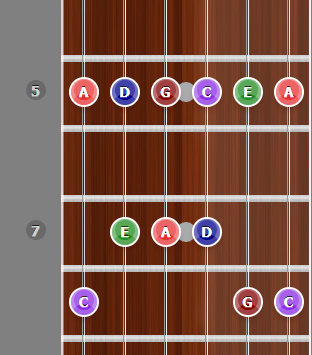
This is a 2 note per string scale, that starts on the low E (6th) on the 5th fret.
Here is the 3 string 2 note, 2 fret grouping on the 1st pattern.
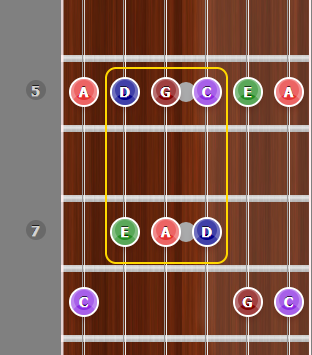
Second Position/Pattern
The second position of the A Minor Pentatonic adds the 5 notes in an additional position,
that extends the 1st Pattern to give you more options.
Here is a simplified version of the second posiition.
This only adds 3 new positions for the E, A, and D notes. The C and G, are left over from the 1st position.
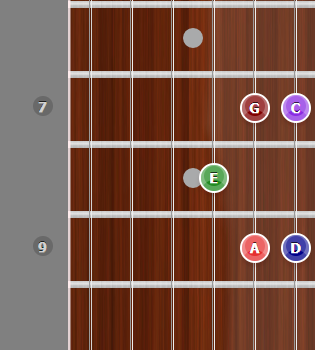
The shortened version gives you a glimpse of the full 2nd pattern.
This pattern starts on the C note on the 8th fret of the low E string.
Below is the full second pattern:
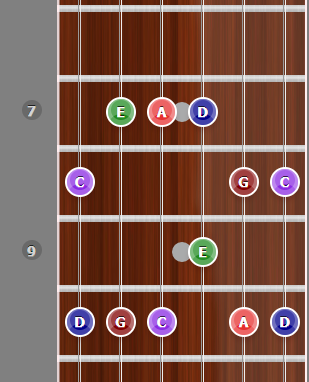
Notice that the notes are the same throughout all of these positions. The notes of the scale never change.
Here is the 3 string 2 note, 2 fret grouping on the 2nd pattern.
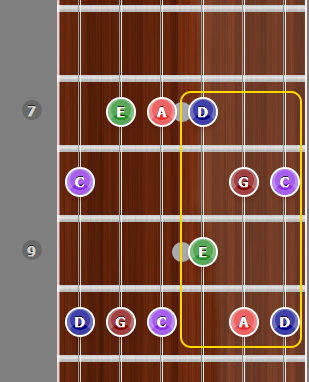
3rd Position/Pattern
Expanding on the A Minor Pentatonic positions we already know, here is the 3rd position/pattern.
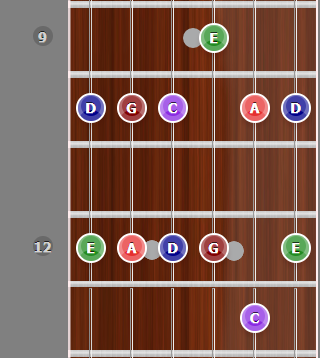
Here is the 3 string 2 note, 2 fret grouping on the 3nd pattern.
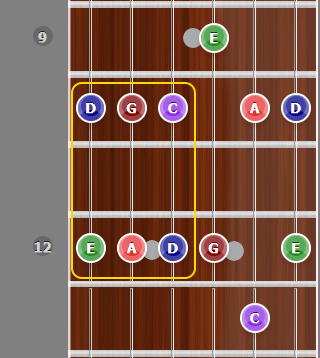
4th Position/Pattern
As we move up the neck, we now have the 4th position/pattern.

Here is the 3 string 2 note, 2 fret grouping on the 4th pattern.
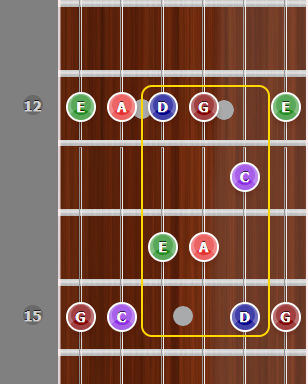
5th Position/Pattern
As we move up the neck, we now have the 5th position/pattern.
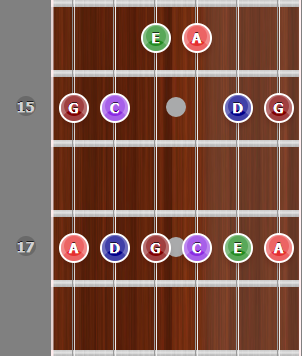
Here is the 3 string 2 note, 2 fret grouping on the 5th pattern (with both the low and high E strings included).
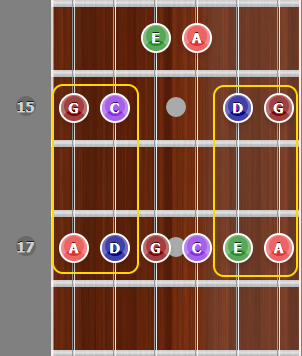
The full A Minor Pentatonic Scale
Here is the full A Minor Pentatonic pattern all over the neck. You should be able to visually find the 5 patterns.

Do not get overwhelmed with the full fretbaord view. Find the patterns that you already know.
If you know them all, great!!! If not, find one you know, then look for the next pattern right above it.
Bends Or Slides In The Pentatonic Scale
Along with hammer-ons, and other means of playing the next note, is to bend or slide the note one step, to reach the next note.
Sliding is a simple move of sliding your fretted note up to the next note.
Bending is a gradual bend of the string, which changes it's pitch. You can bend a half step, whole step, etc., depending on
how far you're able to bend the string. Normally, you would bend to a target note. The target note is the note you're
targeting with the bend. In the first pattern of the pentatonic scale, the best sounding notes to bend are on the G, B and E strings.
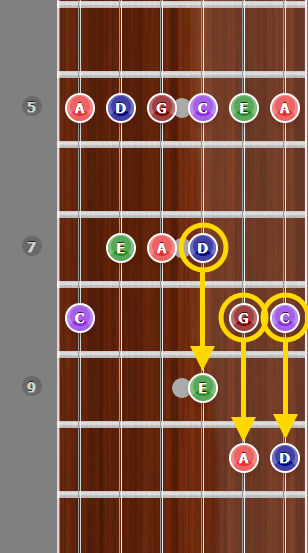
Each are a whole step bend, from D to E (G string), G to A (B string), and C to D (E string)
Here is an example of using bends:
Here is an example of using slides and hammer-ons:
Phrasing
Phasing is an essential part of playing solos. It enhances your ideas, and brings them to a new level.
Phrasing simply means dividing a melody of connected sounds, to enhance their effect.
To break it down further, it means play an idea, then leave a space before jumping into the next phrase.
Singers, horn players, etc., have to take a breath before playing the next phrase.
As guitar players, we can play all day without breaking for breathing. This can be a negative, because
it can make our guitar solo sound less cohesive and less dynamic.
By stopping, and taking a breath between our phrases, we can close out one phrase, and move onto another.
This accentuates the phrase, and closes out that idea. This allows the listener to understand what your playing.
It's a very simple concept, but one that is very hard to remember to do while you're soloing.
Target Notes
If you're playing over an Am Chord, any note in the A Minor Pentatonic will sound fine.
In a solo, you want to emphasize a note at the end of a phrase.
Target Notes are the notes you want to emphasize in your solo.
The notes that sound best are any note in the chord that you're playing over.
So if it's an Am Chord, the notes are A - C - E. All of these notes are available in the Am Pentatonic.
Any of the notes of the Am Pentatonic will sound fine. But we're not looking for fine. We're looking
for something better than fine. If you end your phrase on root, it will sound better than any non-chord note.
You can play any pentatonic note throughout your phrase. But the end of the phrase is what make guitar players stand out.
Wrap Up
The Pentatonic Minor is the first scale that people learn for playing lead guitar, and for good reason.
It simply removes the 2 and the 6 of the scale, because those notes probably wont sound that good over the chord.
If you learn the Pentatonic Minor, and learn how to seamlessly move between the different positions, you
should be able to play a solo over any chord progression.
Along with being comfortable moving between positions, work on your phrasing and hitting those target notes.
It will make you sound like you know what you're doing (even if you don't).
Here is a practice backing track to play the A Minor Pentatonic over. The chords in the progression are Am - C - D.
Listen to how each note sounds relative to the backing track. Practice landing on the root, when the Am gets played.
Practice sliding up/down to the next note. Practice bending the note to the next note.
Bends are an important thing to get right. It will be benficial to use a tuner to make sure you're hitting the note.
The good news is that it's a skill that once you get it, you never forget it.